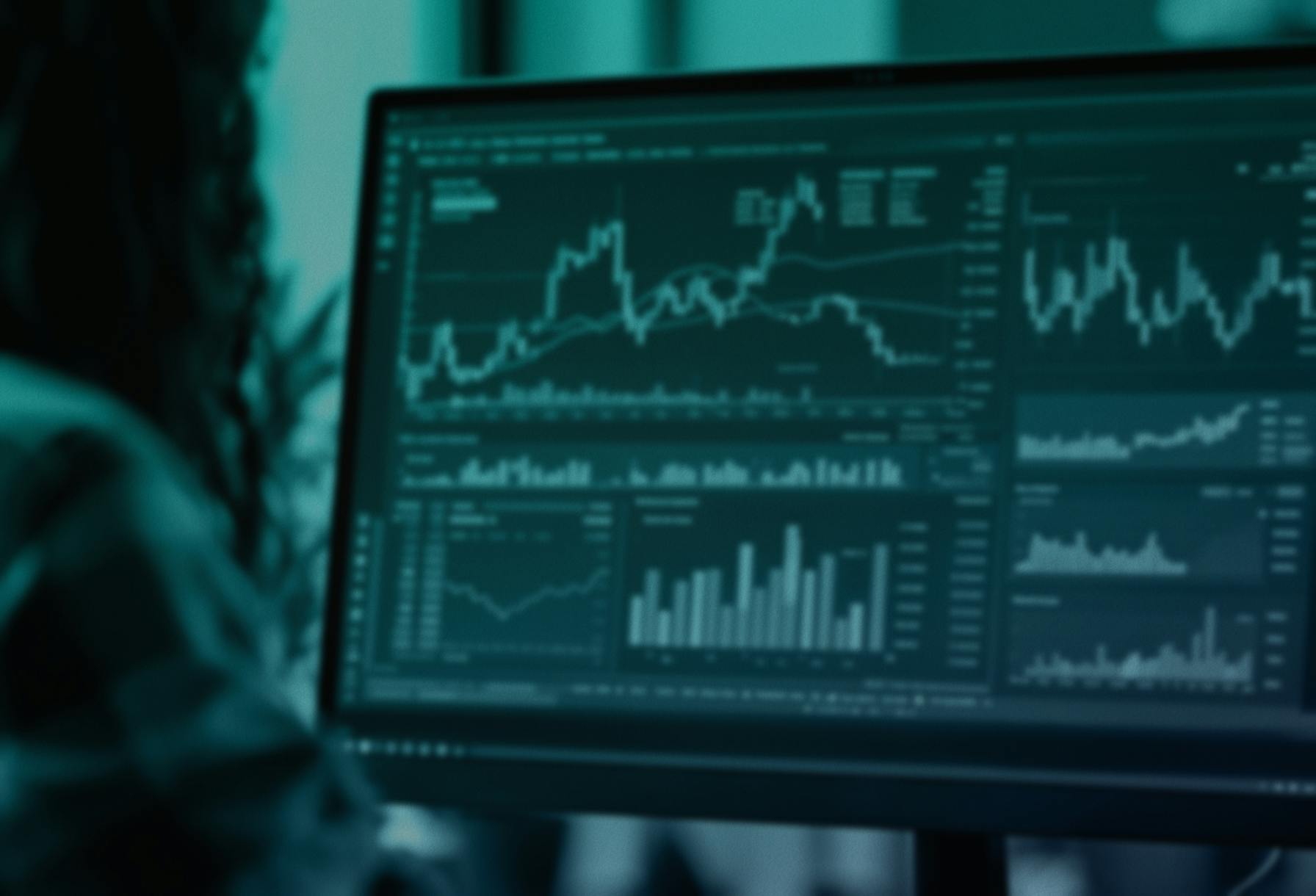
- All
- Tools
- Analytics
- Technical Analysis
- Trading
- Blockchain
- DeFi
- Guides
- Company News
- Educational
- Opinion
- Price Predictions
- Market News
- News
- Trading cases
- Practical guides
- Exchanges
- Trading signals
- Cryptocurrency
- Crypto bots
- Other
Become a crypto master
Learn everything about crypto,
trading and bots

Understanding Machine Learning Algorithms in Cryptocurrency Trading: Complete Guide
This guide explores how machine learning algorithms are transforming cryptocurrency trading, covering core concepts, real-world applications, developing strategies, and integrating with platforms like 3Commas. It details supervised, unsupervised, and reinforcement learning, along with challenges, best practices, and FAQs for traders looking to leverage AI in crypto markets.
Start Trading on 3Commas Today
Get full access to all 3Commas trading tools with free trial period

Introduction
Given the current digital asset marketplaces, machine learning (ML) is changing paradigms and becoming an integral part of modern trading systems. With increasing competition, financial professionals and traders are always on the lookout for an edge, and ML provides an automated means of analyzing data, predicting trends, and making decisions. Unlike technical indicators and discretionary strategies, ML algorithms have the capacity to automate decision-making processes by adapting to various evolving market conditions using both structured and unstructured data.
This guide is informative on the extent of AI deployment in cryptocurrency trading, from algorithmic and real-world frameworks to trading automation solutions by companies like 3Commas. The primary audience of this piece are intermediate to expert cryptocurrency traders – and as such, the focus is put on technical aspects and deriving value rather than sensationalism. Within a wider context, this guide serves as the first part of an installment series dedicated to the roles of AI in crypto trading bots.
Machine Learning in Cryptocurrency Trading
Core Concepts and Relevance
Machine learning encompasses the development and use of algorithms that can learn from data to make predictions or decisions without predetermined instruction. These algorithms are able to adjust to new settings, uncovering intricate relationships in data which would otherwise be painstaking using traditional, rule-based methods.
With regards to trading cryptocurrencies, ML can identify sophisticated price movement correlations, anticipate changes in volatility, recognize liquidity shifts, and even analyze trader perception using unrefined data from social media and news outlets. Such flexibility is immensely important in the crypto market’s hyperactive and information-saturated sphere, where conditions shift quickly and immediate trading resolutions are required.
Typically, the following categories encompass machine learning models used for trading:
- Supervised learning: Involves training an algorithm on a labeled dataset, where the correct output (e.g., price movement direction) is known. The model learns to map inputs to outputs, enabling predictive capabilities. For example, a model might learn to predict whether the next 15-minute candle for Bitcoin will close higher or lower based on technical indicators and recent volume.
- Unsupervised learning: These models are designed to identify structures or groupings within data without prior labeling. In crypto trading, unsupervised models are often used for anomaly detection (e.g., detecting flash crashes), clustering (e.g., grouping similar assets), or identifying regime shifts in market behavior.
- Reinforcement learning (RL): RL models learn by interacting with an environment and receiving feedback in the form of rewards or penalties. Over time, the model optimizes its actions to maximize cumulative rewards. In trading, RL agents can learn to buy, hold, or sell based on current market conditions, aiming for long-term profitability through relentless efficiency.
These ML paradigms offer a powerful alternative to deterministic models and traditional technical analysis. While each type has its strengths and limitations, their strategic integration can create adaptive trading systems that evolve in tandem with market dynamics.
Why It Matters in Crypto Markets
The crypto market is a fertile ground for machine learning due to its distinct characteristics:
- Volatility: The high levels of price fluctuation present in cryptocurrencies offer ample opportunities for ML algorithms to learn and exploit short-term inefficiencies. However, it also presents challenges in model stability and overfitting.
- 24/7 global access: Crypto markets never sleep, which makes real-time data processing and automated decision-making crucial. ML models can analyze and act on data continuously, providing a significant advantage over manual trading approaches.
- Data richness: Beyond price and volume, the cryptocurrency space includes on-chain data, sentiment from social media, developer activity, exchange listings, and more. Machine learning thrives in multi-dimensional environments like this….to a point. Users have to remember the core rule of data analysis: GIGO, garbage in garbage out. Curating appropriate data sources for a model is just as important as the coding.
- Behavioral trading: Retail-driven behavior and social influence can drive extreme price movements, particularly for small market cap altcoins and memecoins. ML models trained on sentiment and behavioral indicators can help anticipate such shifts and identify opportunities.
- Market fragmentation: Dozens of exchanges and hundreds of tradable assets mean prices and liquidity vary widely. ML-powered arbitrage bots can identify pricing inefficiencies and execute trades across multiple exchanges with high speed and accuracy.
Given these factors, ML is increasingly becoming a staple for both institutional and individual traders seeking to build a more adaptive and intelligent trading strategy. It’s particularly useful when deployed through automated trading tools that can monitor and respond to changes in real time, such as crypto trading bots and AI trading bots provided by companies like 3Commas.
Developing Machine Learning Strategies
Define Trading Objectives
The first step in designing an ML-based trading system is defining clear objectives. Different objectives will require different data inputs, algorithms, and evaluation metrics. Common goals include:
- Price prediction: Forecasting future price levels over various timeframes, such as the next 10 minutes, 1 hour, or 24 hours.
- Volatility estimation: Predicting the degree of price fluctuation within a given period, which can inform position sizing and risk controls.
- Classification of market conditions: Identifying whether the market is trending, ranging, or reversing based on data patterns.
- Signal generation: Creating buy/sell signals based on a probabilistic model rather than fixed rules.
Build Strong Features
Feature engineering is often the most critical and time-consuming part of building a trading model. Good features help the model learn meaningful patterns and generalize better to new data. Types of features include:
- Technical indicators: Tools like Moving Averages, Bollinger Bands, and Relative Strength Index (RSI) provide structured representations of price dynamics.
- Statistical transformations: Returns, rolling standard deviations, Z-scores, and momentum measures help contextualize data.
- Sentiment features: Quantified data from Reddit, Twitter, and crypto news sources, processed through Natural Language Processing (NLP) techniques.
- Time-based indicators: Time of day, day of the week, and seasonal patterns can sometimes reveal regularities in trader behavior.
The feature set must be curated thoughtfully to avoid data leakage and overfitting. Using domain knowledge alongside statistical testing is essential in selecting useful inputs.
Train and Evaluate Models
Once features are established, the next step is model training and validation. This involves splitting data into training, validation, and test sets to assess generalization. Key performance metrics include:
- Accuracy and Precision: For classification problems, especially in signal generation.
- Mean Squared Error (MSE): For regression problems, such as price or volatility forecasting.
- Sharpe Ratio and Max Drawdown: Financial performance metrics to evaluate the real-world viability of a strategy.
Backtesting plays a crucial role here. A robust backtesting framework allows traders to simulate their strategy under historical conditions and assess its strengths and weaknesses before going live.
Deploy and Monitor in Real-Time
Deployment is the process of integrating the trained model with live data feeds and execution mechanisms. Tools like 3Commas provide APIs and trading bots that can execute model-generated signals efficiently. Important considerations at this stage include:
- Latency: Ensuring low-latency connections between data processing, signal generation, and trade execution.
- Monitoring and Logging: Keeping track of live model performance, prediction accuracy, and trading behavior.
- Model Drift Detection: Over time, market conditions change. Models should be retrained periodically or adapted dynamically to maintain relevance.
A complete machine learning trading system must be both adaptive and resilient, able to operate autonomously while remaining under careful supervision.
Real-World Applications
Predictive Signal Generation
ML models can be designed to identify high-probability trade setups, offering a more nuanced alternative to fixed rule-based systems. Predictive models use historical price action, order book data, and sentiment to forecast the likelihood of price movements.
For instance, an XGBoost classifier might be trained to signal when to enter a long position in ETH based on a confluence of technical and sentiment indicators. That signal could then be executed automatically by a trading bot on 3Commas.
These systems reduce emotional bias and can be backtested extensively, providing traders with data-driven confidence in their decision-making.
Arbitrage and Market Making
ML models are highly effective in identifying pricing inefficiencies across multiple exchanges or instruments. Arbitrage bots can use ML to:
- Detect price discrepancies
- Predict mean reversion behavior
- Estimate transaction costs and slippage
Market-making strategies also benefit from ML, especially in modeling order flow and dynamically adjusting bid-ask spreads based on volatility and demand.
Such applications are often used by institutional traders and market makers who rely on ultra-fast execution and sophisticated risk models.
Sentiment-Aware Strategies
Natural language processing models allow traders to transform unstructured data into actionable insights. These models score text content from forums, social platforms, and news feeds based on emotional tone, subject matter, and influence level.
An AI trading bot may incorporate sentiment trends into its decision matrix—becoming more risk-averse during negative news cycles or more aggressive when positive sentiment surges.
Real-time sentiment scoring provides an edge in responding to rapid shifts in trader psychology, which often precede price movement.
Risk Management and Portfolio Rebalancing
Machine learning enhances risk management through predictive analytics:
- Stop-loss calibration: Dynamic adjustment of stop-loss levels based on predicted volatility or drawdown risk.
- Exposure management: ML models can detect portfolio imbalances and automatically trigger rebalancing via tools like 3Commas Smart Portfolio.
- Tail risk detection: Identifying fat-tail events that deviate from standard distribution assumptions, enabling proactive hedging.
These techniques are especially valuable in highly volatile market conditions where manual risk controls may fall short.
Integrating Machine Learning with 3Commas
Signal-Based Execution
Machine learning models can integrate with 3Commas through API connections, enabling seamless signal-based trade execution. Once a model generates a prediction, it can instantly trigger a Smart Trade or bot action without manual intervention.
This integration supports:
- Automated trade execution: Deploying AI trading signals directly to DCA bots or grid bots
- Custom signal bots: Allowing traders to feed external logic or ML outputs into existing 3Commas bot frameworks
- Real-time adaptability: Automatically adjusting bot settings based on dynamic model predictions
Backtesting and Optimization
3Commas also supports robust backtesting, but users wanting to simulate how ML-driven strategies would have performed historically can do this backtesting on TradingView and then import the verified strategy into a 3Commas bot via webhook. When combined with TradingView or proprietary ML scripts, this offers:
- Insight into strategy robustness across different market conditions
- Refinement of stop-loss, take-profit, and entry parameters
- Improved portfolio management through quantitative scenario analysis
Challenges and Limitations
Data Quality and Availability
The quality of available market and sentiment data varies significantly between sources. Inconsistent time stamps, missing values, or manipulated volumes can distort model accuracy.
Overfitting and Model Complexity
ML models may capture noise instead of signal, especially when using high-dimensional datasets. Without proper validation, this leads to overfitting and poor out-of-sample performance.
Market Regime Changes
ML models trained on past conditions may struggle to adapt to sudden structural changes, such as regulatory announcements or macroeconomic shifts. Reinforcement learning and frequent retraining can mitigate this but do not eliminate the risk.
Best Practices
- Start simple and validate assumptions before deploying complex models
- Combine ML outputs with traditional technical indicators or market experience
- Use tools like 3Commas to maintain trading efficiency and minimize manual effort
- Monitor all systems closely to detect model drift or unintended behaviors
- Focus on risk-adjusted returns and capital preservation, not just win rate
Conclusion
The domain of cryptocurrency trading has been greatly changed by machine learning. ML technologies optimize how traders analyze data and execute trades, from improving trading strategies to enabling AI-enhanced trading bots. In conjunction with strong risk management frameworks and automated trading platforms like those provided by 3Commas, ML can be integrated into automated, scalable, and efficient trading systems, making them powerful assets.
ML will continue to be a focal point for traders adapting to advancing technologies because it maintains its relevance as platforms for investing in cryptocurrencies mature, along with AI-assisted market analysis and strategy automation tools.
Frequently Asked Questions
Some basic models are accessible, but effective implementation requires coding and data analysis experience. Execution can be streamlined with crypto trading bots.
Popular choices include Random Forests, LSTMs, and XGBoost, depending on data structure and use case.
Performance varies with market conditions. Frequent retraining and rigorous validation are essential.
Yes. Via API, ML-generated trading signals can be used to control bots and automate trades.
Evaluate using Sharpe ratio, drawdown, win rate, and out-of-sample testing results.
ML can recognize complex relationships but often works best in combination with technical indicators.
Overfitting, poor data, unrealistic backtests, and model drift are key concerns.






